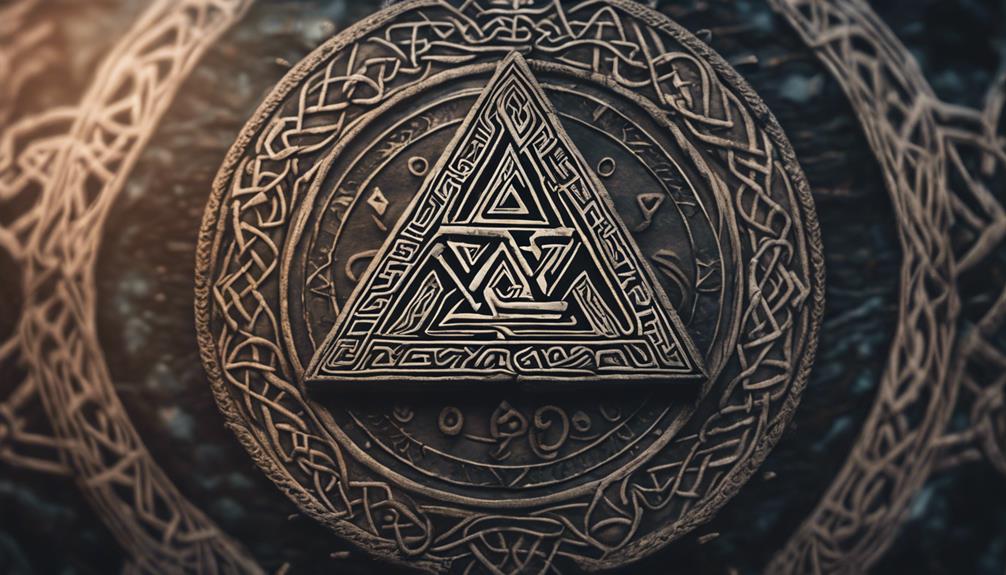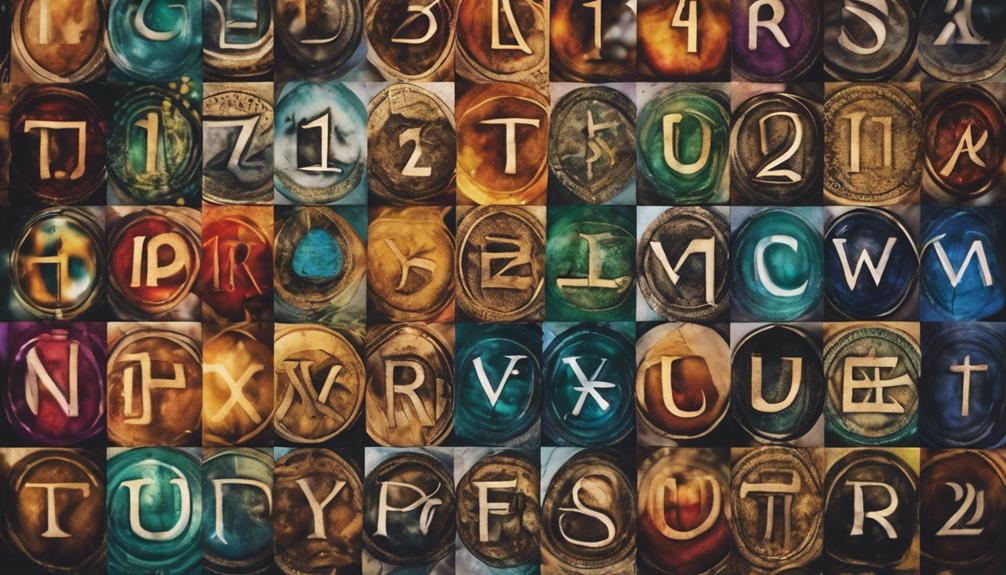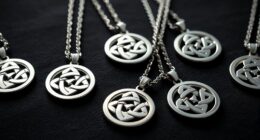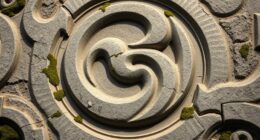Uncovering Norse symbols reveals ancient wisdom and valor. The **Valknut** shows fallen warriors and ties to the divine. **Mjölnir** stands for warrior spirit and God’s favor, even through Christian times. The **Helm of Awe** evokes fear in foes and empowers warriors in battle. The **Norse Compass** guides through life’s thicket, while **Yggdrasil** is the tree of cosmic order and connections. These symbols **protect, strengthen,** and **embolden** people. Learn these emblems for deeper historical and spiritual insights. Dive in to understand these timeless symbols!
Key Takeaways
- Valknut symbolizes fallen warriors and connection to Odin, embodying courage and strength.
- Mjölnir represents warrior spirit, strength, and divine favor, remaining a symbol of protection.
- Helm of Awe features eight arms, instilling fear in enemies and granting courage in battle.
- Norse Compass (Vegvisir) guides and protects travelers through challenges, aiding in navigation.
- Yggdrasil symbolizes cosmic order, unity, and balance, safeguarding life's continuity and interconnectedness.
Symbol of Valhallas Warriors
Symbolizing the fallen warriors and their ties to Odin in Norse mythology, the Valknut holds significant meaning in the Viking culture. This powerful symbol, often associated with slain warriors, represents the connection between the mortal sphere and the divine. Found in Viking tombs, the Valknut signifies the cyclical nature of life, death, and rebirth, reflecting the valor and heroism of those who've fallen in battle. With its three interlocking triangles, the symbol also represents the nine worlds in Norse cosmology, embodying the courage, strength, and protection sought by warriors in times of conflict.
The Valknut's association with Odin, the Allfather and ruler of Asgard, further enhances its significance as a symbol of honor and sacrifice among Valhalla's warriors. Those who wear or display the Valknut signal their allegiance to Odin and their readiness to embrace their fate on the battlefield. As a emblem of bravery and resilience, the Valknut serves as a reminder of the warrior spirit that resonates deeply within the Viking culture.
Thors Hammer of Protection
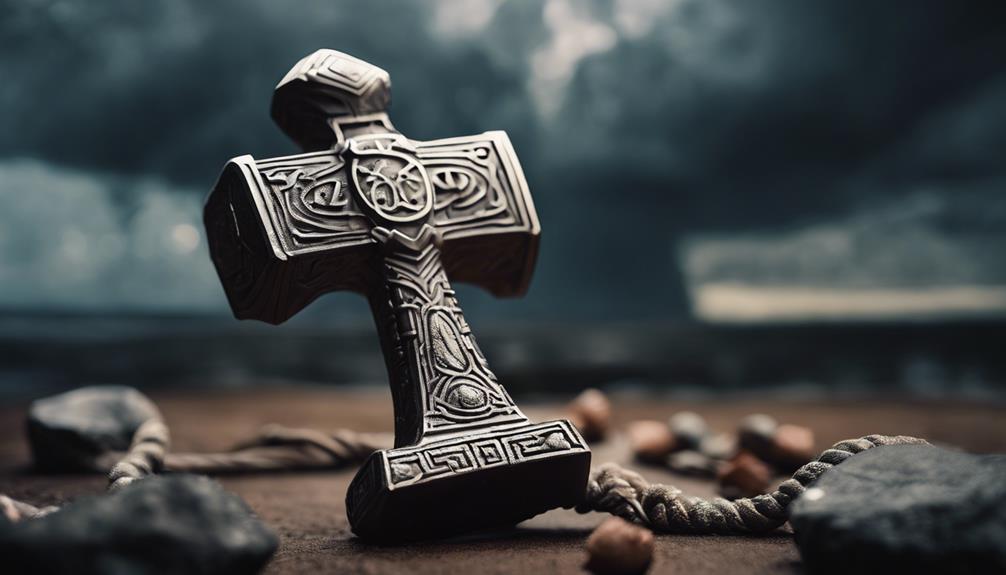
Thors Hammer, or Mjölnir, serves as a potent symbol of protection in Norse mythology. Associated with Thor, the god of thunder and strength, Mjölnir was believed to offer both physical and spiritual defense.
Its historical origins and symbolic power make it a fascinating subject to explore.
Symbolic Power of Mjölnir
With its roots deep in Norse mythology, Mjölnir, known as Thor's hammer, embodies the essence of thunder, lightning, and protective strength. Here are three fascinating aspects of the symbolic power of Mjölnir:
- Warrior Symbol: Mjölnir is more than just a hammer; it represents the warrior spirit and the strength to overcome challenges.
- Archaeological Significance: Found in various archaeological sites, Mjölnir's presence showcases its importance in Norse culture and history.
- Continued Relevance: Despite the shift to Christianity, Mjölnir remained a symbol of protection, with people using it for rituals and as a protective amulet.
Historical Origins Explored
Exploring the historical origins of Mjölnir reveals its significance as a powerful symbol of protection in Norse mythology. Thors Hammer, also known as Mjölnir, was utilized by the thunder god Thor to safeguard Asgard and Midgard from adversaries.
Crafted with magical properties, Mjölnir wasn't just a weapon but a symbol of strength, courage, and divine favor. This powerful symbol was believed to defend against malevolent forces and bestow blessings upon those under its protection.
The intricate design of Thors Hammer symbolizes more than just physical might; it represents the authority and guardianship of Thor in Norse culture. As a popular protective emblem, Mjölnir stands as a testimony to the enduring legacy of Thor's hammer as a symbol of protection and strength.
Helm of Awe
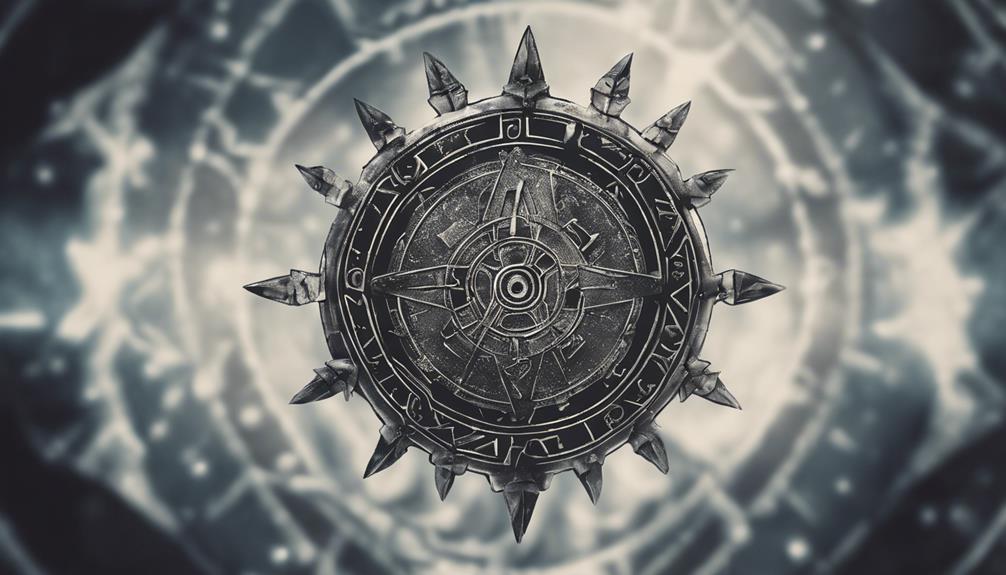
The Helm of Awe, known as Ægishjálmr, serves as a potent protective symbol deeply rooted in Norse mythology. When exploring this Norse symbol, we uncover its fascinating attributes:
- Symbolic Design: The Helm of Awe features eight arms radiating from a central point, symbolizing protection and strength. This intricate design isn't just visually enthralling but also holds deep meaning for those who embrace its power.
- Warrior's Courage: Warriors of the past believed that wearing the Helm of Awe would instill fear in enemies and grant them courage in battle. It served as a talisman of protection, empowering them for the challenges they faced on the battlefield.
- Connection to Odin: Associated with the Norse god Odin, the Helm of Awe was revered for its dual purpose in physical and spiritual defense. Its ties to such a prominent figure in Norse mythology added to its mystique and significance among believers.
The Helm of Awe stands as a powerful symbol of protection and courage, resonating with those seeking strength in the face of adversity.
The Norse Compass
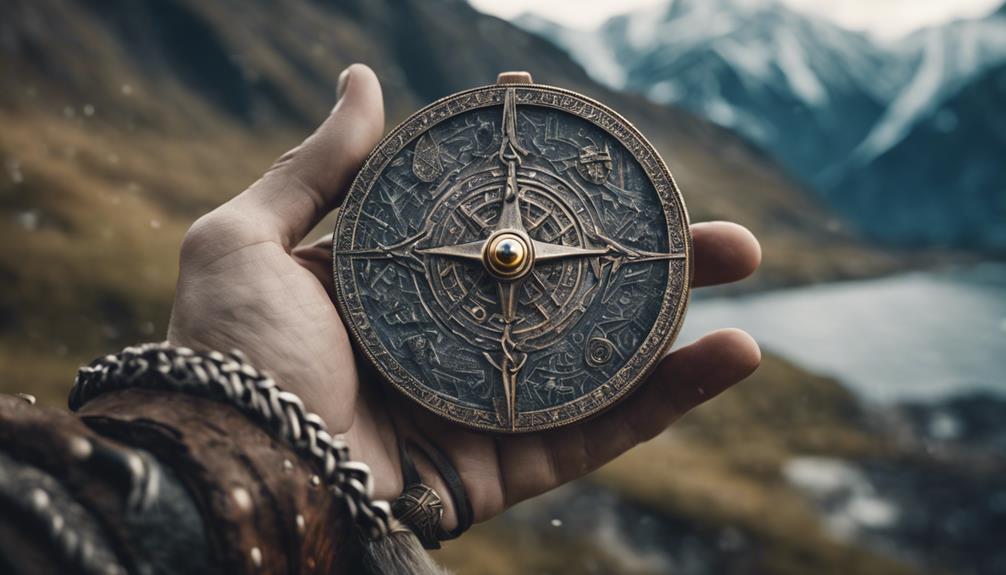
Exploring through the vast seas of Norse mythology, one encounters the Norse compass, a symbol of guidance and protection known as Vegvisir. Vegvisir features eight arms radiating from a central point, providing aid to travelers through challenges and rough waters. Believed to help individuals find their path and navigate through life's obstacles, Norse people trusted Vegvisir to lead them safely on physical and spiritual journeys. This symbol emphasizes the importance of finding direction and protection amidst life's uncertainties.
| Symbol | Meaning | Emotion |
|---|---|---|
| Vegvisir | Guidance | Hopeful |
| Compass | Direction | Focused |
| Protection | Safety | Secure |
The Norse compass, with its intricate design and profound symbolism, serves as a beacon of hope and focus for those seeking guidance and protection. As we investigate the mysteries of Norse mythology, the Vegvisir stands out as a powerful reminder to stay on course and find security in the midst of life's challenges.
The World Tree of Protection
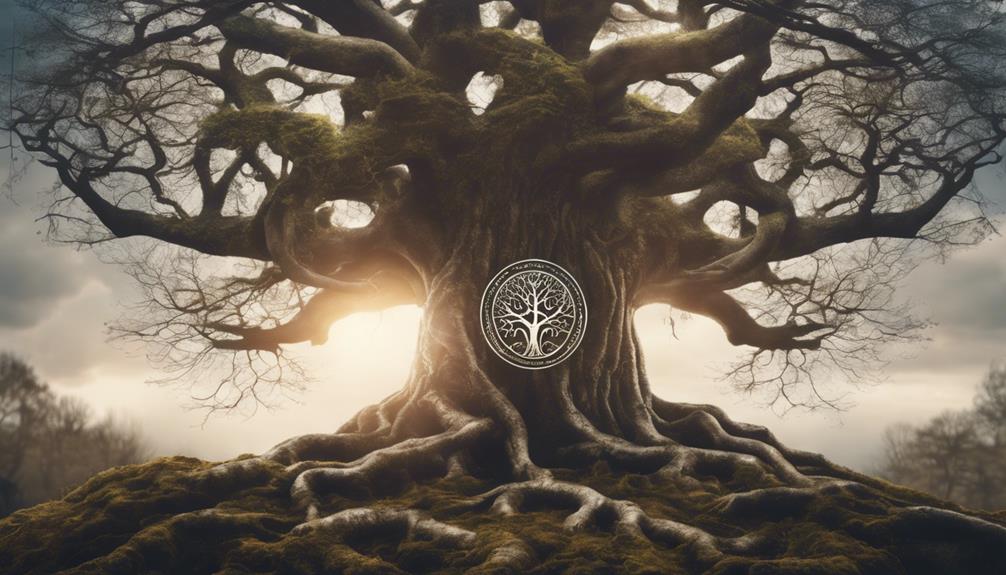
Yggdrasil, the World Tree, stands as a powerful symbol of protection and interconnectedness in Norse mythology. Its roots signify a strong foundation of security, while its branches provide support and guidance.
Understanding the symbolism behind Yggdrasil sheds light on the deep spiritual significance and cosmic order it represents.
Yggdrasil Symbolism Explained
Symbolizing cosmic order and the eternal cycle of life, death, and rebirth, the World Tree Yggdrasil stands as a guardian of youth, harmony, and destiny in Norse mythology. Here are three intriguing aspects of Yggdrasil's symbolism:
- Nine Domain Connection: Yggdrasil serves as the cosmic link between the nine domains of the Nordic universe, emphasizing interconnectedness and unity.
- Axis Mundi Representation: Believed to be an axis mundi, Yggdrasil acts as a bridge between the physical and spiritual domains, symbolizing divine connection and balance.
- Protector of Fate: As the World Tree, Yggdrasil safeguards the threads of fate, ensuring the harmony and continuity of life's intricate tapestry.
The symbolism of Yggdrasil offers a fascinating insight into Norse beliefs and the interconnected nature of existence.
Roots of Protection Symbol
The roots of the World Tree of Protection in Norse mythology extend deeply into different domains, anchoring the universe and symbolizing stability and safeguarding. Yggdrasil, as the protective symbol it represents, showcases the interconnectedness of all things in the cosmos.
These roots not only provide a firm foundation for the universe but also embody the essence of protection and resilience. In Norse belief, Yggdrasil's roots signify the essential role of interconnectedness in maintaining balance and order within the domains.
As we explore the roots of Yggdrasil, we uncover a profound connection to the concept of protection, highlighting the tree's significance in preserving the harmony and cosmic order that define the Norse worldview.
Branches of Support Symbol
With its majestic branches stretching far and wide, the World Tree of Protection stands as a symbol of interconnection and support in Norse mythology. Yggdrasil, the mighty World Tree:
- Symbolizes the cosmic order and the interconnectedness of all things, embodying the harmony and balance of the natural world.
- Serves as a central axis linking the nine domains of the Norse universe, providing continuity and representing the cycle of life.
- Offers support for gods, humans, and creatures alike, showcasing the belief in unity and solidarity within the cosmos.
Yggdrasil's branches not only connect beings but also reinforce the idea of mutual dependence and shared destiny in the Norse mythological framework.
Symbol of Protection From Harm
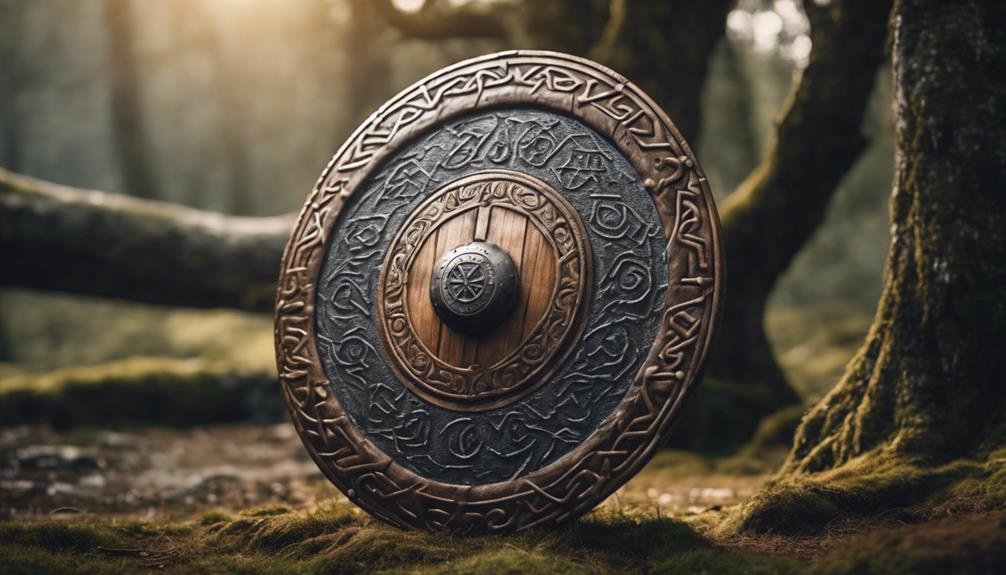
In Norse mythology, protection from harm is embodied by the formidable Helm of Awe symbol. The Viking warriors wore this symbol as a source of courage and defense against physical and spiritual threats. It was believed that wearing the Helm of Awe granted the wearer the strength and protection of Thor himself, especially in times of peril. This symbol wasn't only a shield against external dangers but also a source of inner strength, warding off evil forces and instilling bravery in those who bore it.
Carved onto weapons and shields, the Helm of Awe was a powerful emblem that enhanced protection in battle for the Norse people. Its intricate design and symbolic meaning made it a potent symbol of security and fortitude. The Helm of Awe remains a cherished representation of safeguarding against harm, inspiring those who seek protection and courage in the face of adversity.
Frequently Asked Questions
What Is the Most Powerful Norse Symbol?
The most powerful Norse symbol is often considered to be Mjölnir, Thor's iconic hammer, representing strength, protection, and divine favor. Wielded by Thor, the god of thunder, it defends Asgard and the worlds from various threats.
Associated with fertility, courage, and the ability to channel Thor's power, Mjölnir is a potent emblem of protection, blessing marriages, consecrating oaths, and providing strength in battle against enemies.
Its significance in Norse mythology inspires strength and resilience.
What Do the Norse Symbols Mean?
When exploring Norse symbols, it's fascinating to uncover their deep meanings. Each symbol carries unique significance, such as the Valknut symbolizing life, death, and rebirth.
Mjölnir represents fertility and strength. The Aegishjalmr instills fear in enemies while offering protection. The Vegvisir guides travelers through rough waters.
The Helm of Thor symbolizes protection in battle. These symbols embody courage, strength, and protection, enriching Norse mythology with their powerful meanings.
What Is the Old Norse Magical Symbol?
We've discovered that the old Norse magical symbol is called Vegvisir. This powerful symbol serves as a guide and protector, especially during sea voyages.
With its eight arms resembling a compass, it aids travelers in steering through challenges. Rooted in Norse mythology, Vegvisir helps individuals find their way through spiritual journeys.
Vikings used this symbol to stay on track even in the toughest situations, providing a sense of security and direction in uncertain times.
What Is the Norse Symbol for Protection?
The Norse symbol for protection is a powerful representation of defense. It encompasses various symbols like the Valknut, Mjölnir, Aegishjalmr, Vegvisir, and Yggdrasil, each offering unique forms of protection against evil.
These symbols hold deep meaning in Norse mythology, providing courage, strength, and guidance to those who seek protection. From warding off threats in battle to safeguarding travelers on their journeys, these symbols embody the essence of protection in Norse culture.
What is the significance of Norse symbols in spiritual alchemy?
Norse symbols have deep spiritual alchemy symbols meanings. They hold power in unlocking the transformative energies of the universe. The significance lies in their ability to guide the seeker towards enlightenment and inner transformation. By understanding and harnessing these symbols, one can tap into the spiritual alchemy within themselves.
Conclusion
As we unravel the ancient Norse symbols and their powerful meanings, one thing is clear – there's a rich history and deep significance behind each of these symbols.
But what secrets do these symbols still hold? What untold stories lie within their intricate designs?
Only time will reveal the full extent of their power and mysteries. Keep exploring, keep learning, and who knows what other hidden truths you may uncover.

